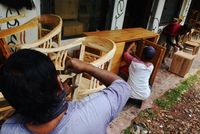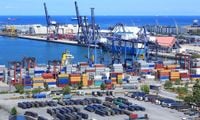On Sunday, April 13, 2025, workers were completing chair production at a furniture industry in Ciputat, South Tangerang, Banten. The atmosphere in the facility was tense as furniture exporters to the United States expressed deep concerns over a significant policy shift by the U.S. government. President Donald Trump’s administration has raised import tariffs on various products from Indonesia by up to 32 percent, a move that many in the industry fear could severely undermine their export competitiveness.
This tariff increase has sparked widespread anxiety among Indonesian exporters, particularly in the furniture sector, which heavily relies on the U.S. market. According to industry insiders, this policy could lead to a decline in demand for Indonesian furniture in the U.S., potentially resulting in reduced production and significant layoffs. The situation is dire, as the U.S. has traditionally been a key market for Indonesian furniture exports.
“We are worried about the impact of these tariffs on our business,” said a local exporter, highlighting the potential for decreased orders and the subsequent need to cut back on staff. The furniture industry is not alone in facing these challenges; other sectors, such as textiles and palm oil, are also bracing for the fallout from U.S. protectionist measures.
The textile industry, in particular, faces significant hurdles due to the same 32 percent tariff. This increase threatens the competitiveness of Indonesian textile products in the U.S. market, opening opportunities for competitors like Vietnam and Bangladesh to fill any gaps left by Indonesian exports. The situation is compounded by the fact that many Indonesian manufacturers may have to redirect their focus to alternative markets, a process that can be both time-consuming and resource-intensive.
Footwear, another major export from Indonesia to the U.S., is also expected to see a marked decrease in demand. Experts predict that this could lead to a drop in production and job losses in the sector. “With the tariffs in place, we are likely to see a significant reduction in orders from our U.S. clients,” noted an industry representative.
Moreover, the lighting and furniture sectors are not immune to the tariff's effects. The increased import duties make Indonesian products less competitive compared to those from countries that either face lower tariffs or none at all. As a result, local producers are scrambling to devise strategies to maintain their market share in the U.S. or to explore new markets abroad.
In a related development, the Indonesian palm oil industry is grappling with its own set of challenges following the U.S. government's imposition of the same 32 percent tariff. This reciprocal tariff is expected to hinder exports, particularly to the U.S., which has been a primary destination for Indonesian palm oil products. In 2024 alone, exports of Crude Palm Oil (CPO) and its derivatives to the U.S. were valued at approximately USD 1.7 billion, with oleochemical exports reaching USD 0.52 billion.
Sahat Sinaga, the Executive Director of the Indonesian Palm Oil Association (GIMNI), commented on the situation, stating that the tariff is a direct response to the large trade deficit the U.S. has with Indonesia. He noted that while Malaysia faces a lower tariff of 24 percent, Indonesia is at a competitive disadvantage, suffering a 4 percent loss in the U.S. market.
“We hope the government can negotiate to lower the reciprocal tariff to a more manageable level, ideally around 10 percent,” Sahat said. He believes that through effective negotiations, the position of Indonesian palm oil in the U.S. market can be preserved without becoming a barrier to trade.
In the event that negotiations do not yield favorable results, Sahat advised palm oil exporters to leverage trade offices in Singapore. This strategy would allow them to re-export Indonesian palm oil products to the U.S. at a significantly reduced tariff of just 10 percent. Furthermore, he suggested eliminating the export tax on palm oil in Indonesia to enhance competitiveness.
To bolster the competitiveness of Indonesian palm oil products, particularly in Pacific Rim countries like Canada and Mexico, Sahat proposed developing Special Economic Zones (KEK) in regions like Papua. Such initiatives could help improve the overall market position of Indonesian products in a challenging global landscape.
The imposition of these tariffs has sent shockwaves through various sectors of the Indonesian economy, prompting urgent calls for action from industry leaders and government officials alike. As the situation unfolds, stakeholders across the board are keenly aware of the need for strategic responses to mitigate the adverse effects of U.S. trade policies.
With the stakes so high, the coming months will be critical for Indonesian exporters as they navigate the complexities of international trade amid rising protectionism. The resilience and adaptability of these industries will be put to the test as they seek to maintain their foothold in the U.S. market while exploring new opportunities abroad.






